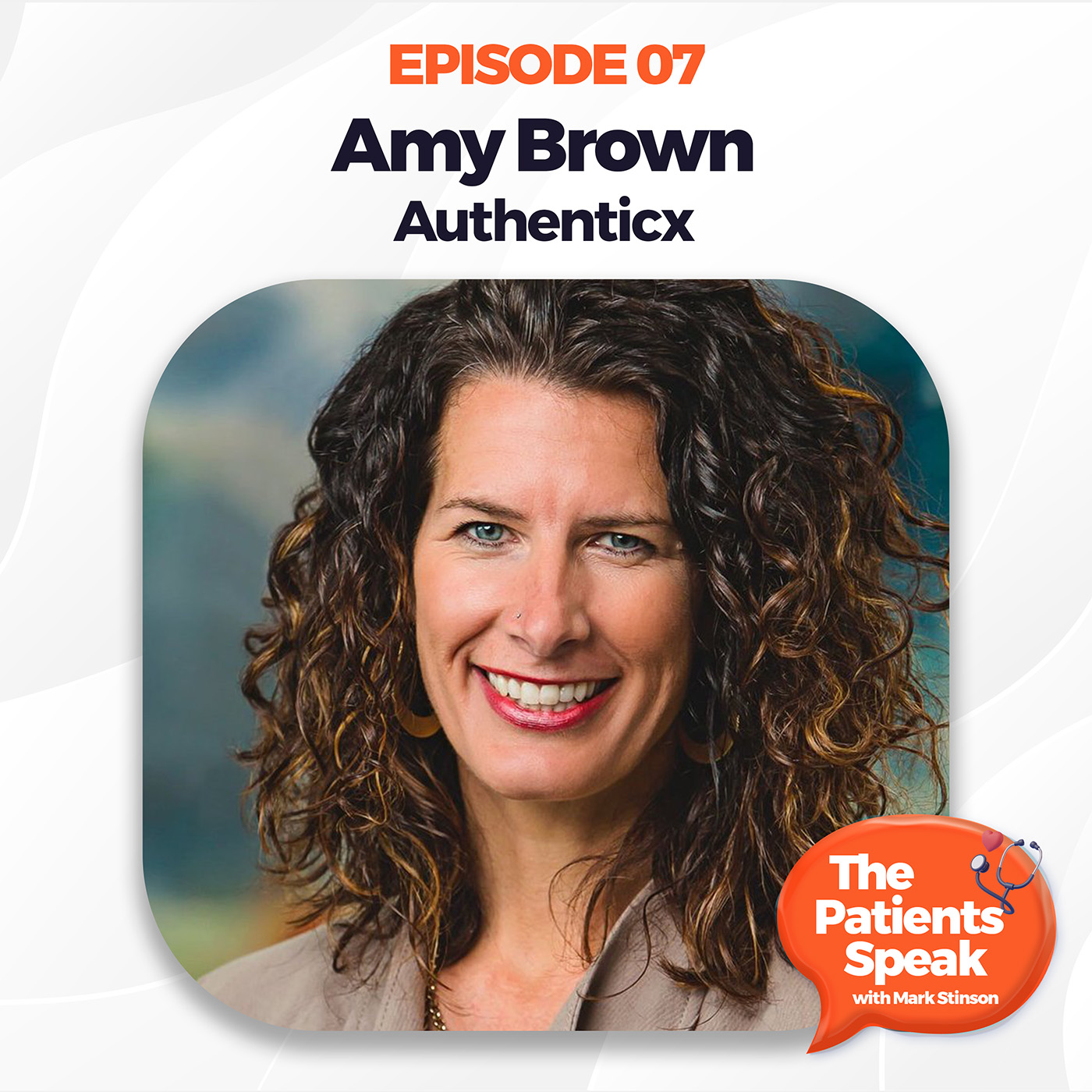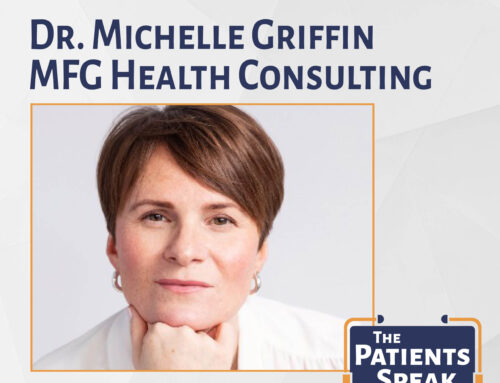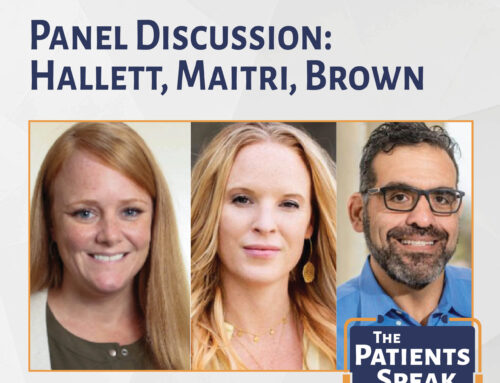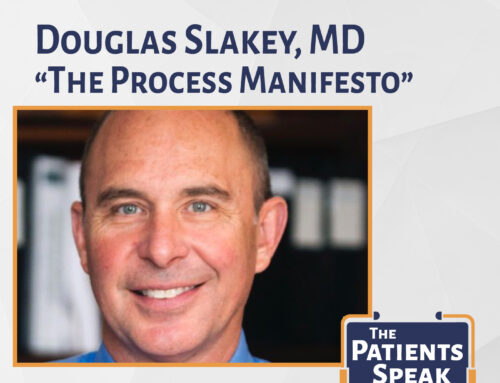Welcome back friends to our podcast, The Patients Speak. Where we learn about the voice of the patient and how the patients can contribute more to the science and business aspects of innovation in the world of medicine.
Today our conversation is going to focus on new technologies and new platforms to improve our listening, how we really hear the patient voice and understand the emotions behind that experience? Our guest is Amy Brown, CEO and founder of Authenticx.
Mark Stinson, host:
Our guest is Amy Brown, the CEO and founder of Authenticx.
Amy Brown, guest:
The fact that the more those leaders can listen and get closer to the voice of their patients, the more informed, the more empathetic, and the more enlightened they’ll be as they set forth policy.
Mark Stinson, host:
Welcome back, friends, to our podcast. We’re combining the business and science side of innovation with the patient voice, and today our conversation is going to focus on new technologies and new platforms to improve our listening. How do we really hear that patient voice and understand the emotions behind that experience? And, our guest is Amy Brown, the CEO and founder of Authenticx.
Amy Brown, guest:
Thank you. It’s so great to be here.
Mark Stinson, host:
As a founder of this company, you bring your experience in government affairs, in operations of a healthcare organization, a payor, even inside a government organization to underserved patients. How do you feel like that experience informs what you’re trying to do now?
Amy Brown, guest:
Yeah. I would actually attribute much of my background to why I started Authenticx. You know how it is in life where sometimes you have these experiences, and you’re not quite aware as they’re happening that they’re preparing you for the future, but then you get to the future, and you look back, and you realize, oh, it all makes sense now. And, that’s really the case for me.
I, um, I grew up the daughter of a surgeon, and even though he spent most of his, uh, working hours, you know, in the operating room, he did tell me at an early age, you know, “Amy, if you ever really want to understand the diagnosis of a patient, all you really need to do is listen to them, and they will guide you to where, where you need to go.” And, while I didn’t follow directly in his footsteps as a clinician, I, I did, my early education was in social work, and I think combining that upbringing, and that education with the business of healthcare, and working in the day in, day out grind of, of, you know, health insurance, and pharmaceutical, manufacturing really helped prepare me for, um, for what I’m doing now.
Mark Stinson, host:
Mm-hmm. So, tell us about how, uh, Authenticx, and how it works, and kind of how the platform, what could I say, curates these patient voices and conversations.
Amy Brown, guest:
Yes. So, uh, most healthcare organizations that are of any size and scale have ways of communicating with their customer, and their customer might be a patient. Ma- many oftentimes, it is, but it also might be physicians or other stakeholders in the healthcare system. And, they typically are communicating via telephone call, or, uh, chat, or email, uh, but in most cases, those interactions are recorded. And, so, what Authenticx does, is we acquire or ingest those customer conversations into our software platform, and we use machine learning algorithms and other forms of AI to listen at scale to these customer conversations to surface the big themes, and the gnarly issues, which, there are many, that healthcare leaders need to hear. Um, and it helps them prioritize what actions they’re going to take to improve the healthcare system.
Mark Stinson, host:
Well, this certainly seems like, uh, bringing all of this and collating it together, uh, would, at scale. I love this term. You know, it’s not just, here’s some verbatims or selective quotes that we pulled out, but rather, gathering many of these. He- do you find that the healthcare executives who are reading these, uh, reports of, of this output find that there’s a information gap that the patients are looking for, or is there a emotional gap? Is there a, you know, some other kind of, uh, like I said, you know, what’s the missing piece that the executives are hearing that maybe they missed in other kinds of listening?
Amy Brown, guest:
One of the most profound experiences of doing our work is trying to bridge the empathy gap, honestly, between healthcare executives and the consumers, the patients that they’re serving. The reality is, is that most leaders in healthcare enterprises, they got into the business for the right reasons, but as you excel in your career, you get farther and farther away from that patient, uh, experience, and that patient voice. What we do at Authenticx is, we create a very efficient, effective, scalable way for leaders to get in touch with what’s going on with their customers by leveraging a data source they already own, but i- it feels very inaccessible to, to executives, because a large telephony platform, a large company might take millions and millions of calls or chats every year.
And so, how does a healthcare executive even know where to start? And, if they do sit down and listen to a call or two, how do they know that that’s representative of the, the, the average experience? And so, we have figured a way to curate, uh, the conversations that executives need to hear most, and what we find is that when an executive pairs, uh, you know, data visualizations, like bar graphs, pie graphs, that, that help them understand the, the quantity of a topic or an emotion, and then, you pair that with the literal voice of the customer, where they’re listening to examples of that data point that they can see, that is where, um, action is unlocked, because executives are being fed in their cognitive brain, but also in their gut. (laughs)
One they hear something, they can’t unhear it, and they have to take action. And, it just creates, yeah, you know, we talk about scalable listening. It creates scalable empathy throughout the organization.
Mark Stinson, host:
Yes, and I, I read a recent, uh, post of yours where you talked about too many patient experiences that become an eddy, uh, and it goes downwards. It’s like, they have a bad initial experience. Then, they try to fix it, or they try to overcome it. It gets worse, and worse, and worse. And, I think we’ve all experienced that in our own customer experience journeys along the way, and, let alone patient journeys. But, uh, where, where could this help turn that around, or at least stop the downward spiral?
Amy Brown, guest:
Yes, so, eddies are, um, are the Authenticx, uh, phrase, and we also have built a metric and a machine learning algorithm around this. The eddy effect is when a customer gets stuck in their journey, and they end up putting forth, uh, more effort than should be required to solve a single problem. And, I am certain that all listeners (laughs) on this podcast have been through that. I just went through an eddy myself two days ago.
Um, so, it, it happens in mass proportions in the healthcare industry, and, and the root of it is just the incredible, uh, complexity that our healthcare system has been built up around. And so, what our clients do when they follow the prevalence rate of the eddy effect within their customer experiences, um, is they leverage the Authenticx platform to do some root cause analysis. Well, what is driving the eddies? Which processes, which parts of our technology are creating confusion or are causing people to have to cycle back with us over and over again? And, what we see leaders do is make changes in their operations, in their communication, in their training of their team members to try to smooth out that customer journey. And, as they do that, they watch through our platform, the eddy effect prevalence rate track down over time, so that they know, uh, the actions that they’re taking are having the intended impact.
Mark Stinson, host:
And, I wanted to ask you about, uh, some of the different market segments, and, and industry areas that you’ve worked in. Certainly, life sciences, like pharma, devices, diagnostics, and so forth. Uh, but also the providers themselves in the clinics, and then the payors. Uh, and then, uh, look ahead to clinical trial recruitment, but maybe we could start with, uh, pharma and life sciences. Can you share an example in which listening actually did change the behavior of the company, that they learned something that they said, “We, we’ve got to stop this and turn this bus around.”? (laughs)
Amy Brown, guest:
Absolutely. There are many examples. So, in, in pharma and life sciences, um, you know, there are these pretty expensive specialty medications that the company invests a ton of money (laughs) uh, in putting forth to market, and one of the most critical things for that pharma manufacturer is to ensure that patients get access to those medications, but getting access is not easy, right? Because there’s the health insurance aspect of the patient’s journey. There’s the provider aspect of writing the prescription.
And, so, pharma companies have set up these patient support programs that are serviced through call centers to try to help patients get access to medication to help smooth the interactions between their provider and their, uh, health insurance company, to try to get on and stay on the therapy that they’ve been prescribed. And, we have examples where a care model has been devised by a market research team within a pharma company. They imagine or make assumptions about what that customer experience will be.
But, the data source of call center data is what we would call real-world data, and what happens in, uh, when a, when a launch occurs with Authenticx is these kind of market research team members and the care model design team members are hearing the reality of what customers experience in their journey. And so, we’ve seen, um, changes in the online enrollment experience for the program. We’ve seen changes in how the nurse line communicates with, uh, patients and the provider to make it easier and less confusing. We’ve seen examples of companies investing more in taking the customer, the patient out of the middle of a situation. Rather than sending them back to their doctor or their payor, they step in and help be a navigator on their behalf. And, this is all, you know, actions that are taken just through the active understanding through listening.
Mark Stinson, host:
Well, and I think about the sub-title of our podcast, Accelerating the Patient Journey. You know, the patient really doesn’t know the difference between the company, the provider, the payor. I mean, they’re just trying to get the treatment, right?
Amy Brown, guest:
Exactly.
Mark Stinson, host:
And speed up, uh, their diagnosis, and get, get to feeling better, uh, and more healthy. H- how can we, as healthcare executives, and even providers, think more patient journey, rather than simply our little segment of it?
Amy Brown, guest:
Yes. You know, one of the biggest insights we’ve been able, able to glean, because we listen to provider interactions, payor interactions, pharmaceutical company interactions, is that the patient is lost between the three. They are, they are left on their own to navigate between those three verticals, and the more that healthcare executives can broaden their view and their lens to understand the other barriers, hoops that patients have to jump through, um, and the more they can agree to, uh, a, a smoother, more streamlined process for patients, uh, the better they’re going to be setting up their patients for success.
Um, y- you know, I think in the US healthcare system, because of the diversity of, uh, of providers, of payors, o- of pharmaceutical companies, everybody has their own set of rules, and, and engagement, how patients should get engaged with their particular brand and product. And, uh, the more that we can agree to a standard set of operating rules so that patients, uh, can really be educated on how to navigate our healthcare system, the, the, the more of an impact we’ll make on, uh, making it easier for patients.
Mark Stinson, host:
Well, my guest is Amy Brown, the CEO and founder of Authenticx. And, Amy, uh, now let’s bridge to clinical trial recruitment, the sponsor and producer of this podcast, 83bar, you know, goes way back in the research cycle, and says, “We need more patients to participate in clinical trials to help the companies develop these new medications, these new treatments, and so forth.” What, what do you think about the listening at that stage? I mean, what are we trying to learn? What could we learn if we really aggregated all this listening, and what patients feel, going back to your empathy word, what patients feel about being part of clinical research?
Amy Brown, guest:
Sure. Listening to clinical research conversations, conversations between patients and, uh, providers, or patients who have agreed to participate in a trial would be extremely valuable in understanding the mindset of patients who are, uh, dealing with a particular illness, condition, disease. Um, y- they, uh, are very emotional conversations that, um, i- in which patients bring their vulnerabilities, their fears, their questions. You also learn a lot through conversational data about the environmental impacts on that, uh, patient or patient population. And, what I mean by that are, um, societal factors, familial factors, um, caregiver factors, health education, uh, transportation, all of these things that play a role in the reality of, of, of, um, how a health treatment of any kind may be able to, to have an impact.
I think, as a country, we’ve, we’ve done a lot in the area of research using structured data sources, like lab, and clinical data, and claims data, and we have a good sense of, um, an, an, uh, improving sense of comorbidities, and, and how clinical diagnoses can lead to certain types of health outcomes. Where we’ve not had enough innovation is in understanding the psychosocial factors of healthcare, and conversational data just has such a wealth of insight to offer, no matter what side of the continuum you are in the healthcare field.
Mark Stinson, host:
Well, I thought I would pause and underscore that. You used a couple of great words there, mindset, first of all, does imply, you know, their emotions, not just their factual gaps, right? And, this psychosocial part. And, I’m wondering, how does your platform capture these more emotional terms? I mean, if we were listening for either, “I’m excited, I’m hopeful,” you know, “I’m motivated,” or, “I’m fearful. I have questions, but I know I need to explore something that might be in a clinical trial rather than already commercially available.” H- how do we distinguish that?
Amy Brown, guest:
Sure. So, we have machine learning algorithms that are designed to detect words that indicate emotion. And, we also use sound wave analysis to try to understand how tone, uh, coupled with words may indicate certain emotions, and the top two emotions we hear that are in kind of the negative sentiment realm are frustration and confusion, but there are, there is a big difference between frustration and confusion, and there are implications depending on if your patient population is frustrated versus confused.
And so, having a, a generic label of negative sentiment is just not good enough, (laughs) i- in terms of, of knowing what to do about it and what it means. And so, we’ve really been focused in our research and data science work on getting deeper than just a sentiment score to more granular levels of, of emotion. And then, pairing those emotions with what the key topics are in the conversation. So, is that frustration around your billing program, or is it around your, uh, prior authorization experience? Is the confusion about how you market your benefits, or is it around how you run your step therapy program? I mean, those are all really important things to understand at scale, um, and just having a single data point of negative sentiment just doesn’t give a leader enough context to know what to go do about it.
Mark Stinson, host:
Well, I’d also like to rewind the tape a little bit to the beginning, where we talked about your passion and focus sometimes on underserved populations, and I’m wondering, in clinical trials, is there the same kind of underserved, you know, segment, where patients, or, in this case, clinical trial participants, don’t know about, or don’t have access, or can’t, uh, navigate their way to a trial? How do we improve the access, improve the diversity and equity in clinical research?
Amy Brown, guest:
Absolutely. I mean, I think in all realms of, uh, healthcare in this country, we need, we know that, uh, inequities exist in the research and delivery side of healthcare. And, one of the most important things we can do is deeply understand the lives of, of the patient population, and be very intentional at seeking out populations that are underrepresented in the data source.
I think, so often, systems of care are constructed based on highly biased constructs, and that there are, you know, centuries of voices that have not been infused into, into the makeup of that system of care. And so, for example, at Authenticx, when we’re listening to a large data set, it’s important to know whether this patient population is commercially insured, Medicare insured, Medicaid insured, uninsured, underinsured, as we look at the lens of, what are the topics, the emotions, the social determinants of health that are all being teased out from this data source? And, that helps leaders start to really get a, a good glimpse of how care models and designs need to take into account those, those social factors, those demographic factors, those geographical factors.
Mark Stinson, host:
Yeah. Fantastic. Well, Amy, also in your background, and I’m thinking about the times that you sat not only at the board room table, and the C suite, but also at the seat next to the governor, perhaps, talking about, uh, healthcare delivery. What do our government officials, you know, Medicaid, Medicare, our aging population, representative of so many of these social segments we’ve been talking about, but what do you think our government officials need to hear from the patients?
Amy Brown, guest:
Yes. What a great question, and I remember, my government healthcare days were at the earlier stages of my career, and I really thought I was at the epicenter of all there was to know (laughs) about healthcare. Wh- and it was a great way to start my career, but what I got into-
Mark Stinson, host:
I think we all feel that way in the early part of our career. (laughs)
Amy Brown, guest:
(laughs) Yeah, that’s probably fair. You start to realize how limited your knowledge really is.
Mark Stinson, host:
There you go.
Amy Brown, guest:[inaudible 00:21:01]
Mark Stinson, host:
I love that, Amy.
Amy Brown, guest:
(laughs) No, but, you know, I, I, what I hear in, in these conversations is a desperation for health, and particularly in the area of, um, accessibility to needed care, and in navigating this complex system. I mean, the reality is, you and I both work in healthcare, and even on our, you know, in our personal lives, we struggle with navigating the healthcare system. And, if you consider this with folks who don’t necessarily have the same experiences, or background, or education in the healthcare space, imagine the barriers and the complexity that they are faced with as they try to take care of themselves?
So, governments need to hear how confused (laughs) the population is, and they need to continue efforts to make care much, much more accessible, and certainly taking into account, and I know strides have been made, not only the medical side of the equation, but the psychosocial side of the equation. You’re not going to get to the health outcomes you want as a government, as a people, unless you’re dealing with and seeking for the truth of both sides of that equation, and listening for patient perceptions, patient experiences is the best way to get that understanding.
Mark Stinson, host:
Wonderful. Well, Amy, what a terrific conversation. I really appreciate you being on the program, and I guess to carry the theme forward, I would like to me- be a better listener right now. I would, I would love to have you summarize what might be a call to action for listeners in any of those segments we’ve been talking to. What would be our path forward, in your view?
Amy Brown, guest:
If I zoom out to this conversation, uh, Mark, I’d say that we’ve been talking about the power of listening, and the criticality of listening to patient voices in a different and new way, a way that is scalable and provides strategic value to the leaders who are empowered to set policy for healthcare consumers. And, the fact that the more those leaders can listen and get closer to the voice of their patients, the more informed, the more empathetic, and the more enlightened they’ll be as they set forth policy.
In terms of one step that listeners can take, I would encourage them to go back to their organization with whi- which they work and find out, how do they listen to the voice of their customer today? Is it primarily through survey? Is it primarily through interview or anecdotal conversations? And, is there a more systemic way, and a more ongoing cadence that the organization can take to listen to the voice of their customers?
Mark Stinson, host:
Wonderful. Thanks for that summary. Well, listeners, my guest has been Amy Brown. She is the founder and CEO of Authenticx, a listening technology platform that can collate many of your customer interactions and really provide insight into those customer experiences. Amy, thanks so much for being on the show.
Amy Brown, guest:
Thanks, Mark. Appreciate it.
Mark Stinson, host:
So, for now, I’m Mark Stinson, and we want to thank 83bar for creating this channel to help all of us in the healthcare field listen better to the patients speak. Bye for now.





